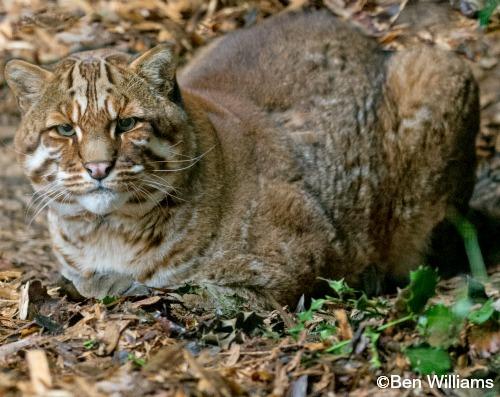- HB Length: 66-105 cm (26-41″)
- Tail Length: 42-57 cm (16-22″)
- Height: Appr. 40 cm (16″)
- Weight: 8.5-15 kg (19-33 lbs)
- Pop. Trend: Decreasing
The Asiatic golden cat is remarkably varied in its pelage. The most common coat colour is golden or red brown, but it may also be dark brown or even grey. Melanistic individuals have been reported and may be predominant in some areas of its range. There is also a spotted form which is called an “ocelot morph” due to its ocelot-like rosettes. If biogeographic patterns exist in regard to the different coat colour types is not known yet and needs further investigation.
The most distinct features of this cat are the white lines bordered with dark brown to black running across the cheeks, from the nostrils towards the cheeks, at the inner corner of the eyes, and up the crown. The rounded ears have black backs with a grey spot. The chest, abdomen and inner side of the upper legs are white with light speckling. The legs and tail are grey to black at the distal ends. The terminal half of the tail is white on the underside and is often carried with the end curled dorsally. Males are larger than females.
Distribution

The Golden Cat is a nocturnal forest dweller, preferring sub-tropical and tropical evergreen forests, but they occasionally frequent more open areas with rocky tracts. In parts of China they are known as the ‘rock cat’. They are found from Nepal and northeast India through Southeast Asia, China, Thailand, Malaysia and Sumatra, but not on the island of Borneo.
In a protected area in Sumatra, all records were from lowland forest, with none from the montane forest where Clouded Leopards Neofelis nebulosa and Marbled Cats Pardofelais marmorata are found. Hill forests of India also contain Clouded Leopards and Marbled Cats, but no Asiatic Golden Cats.
Camera trap photos of both the spotted form and the more common reddish coat have been taken at 3,730 metres in Bhutan dwarf shrubs and grassland, setting a record for high altitude sightings.In 2009, camera trap photos in Nepal obtained the first-ever picture of a melanistic Golden Cat in the wild.
During a field study in Thailand, one adult female had a home range of 32.6 km2,, which was overlapped 78% by a male’s range of 47.7 km2 . Asiatic Golden Cat ranges were 20% larger than those of the Clouded Leopard, although the two cats were similar in activity and distance travelled.
Ecology
The Asiatic Golden Cat is one of the least studied cats in tropical Asia, and little is known of their ecology. Activity levels of two radio collared cats in Thailand were found to be diurnal and crepuscular, although some camera trap photos were obtained at night.
The Asiatic species was once thought to be closely related to the African Golden Cat Caracal aurata although the two are separated by more than 6,400 kilometres. Recent genetic analysis however, has determined they are not closely related, in spite of the many physical similarities.
Although Asiatic Golden Cats can climb well, they spend most of their time on the ground, carrying their long tail curled up at the tip. They are reported by tribesmen in Thailand to have their young in the hollow of a tree.
Reproduction
After a gestation of 75 – 80 days, one to three kittens are born, weighing approximately 250 grams. Their eyes open at around nine days, and they are weaned at six months. Kittens have longer, thicker coats than the adults, but show no pattern. They are slightly darker than the adults. This attractive Asian carnivore has in the past been fairly common in European zoos, although their reproductive rate was not particularly good. Worldwide, there are currently less than a dozen in zoos. There is a high incidence of females being killed by their mates, even in well established pairs. Maximum longevity has been reported at 20 years.
Conservation
There is a general lack of information on Asiatic golden cat populations and their status, as well as a low level of public awareness. However, the main threats to the Asiatic golden cat appear to be habitat loss and alteration due to deforestation across its range. Southeast Asian forests are undergoing the world’s fastest regional deforestation rates due to the expansion of oil palm, coffee, acacia, and rubber plantations.
The Asiatic golden cat is also threatened by hunting for its pelt and bones which are used in traditional medicine, and also for its meat which is considered a delicacy in some areas. In some regions people believe that the consumption of Asiatic golden cat meat increases strength and vigour
The Asiatic golden cat is also killed in retribution for livestock depredation. A study in villages in Sumatra indicated that Asiatic golden cat occasionally preyed on poultry and were often persecuted as a result. They are reported to also take larger animals such as sheep, goats, buffalo calves and other ungulates, leading to conflicts. In some areas, disease transmission is considered anther threat to the species.
The Asiatic golden cat is listed in Appendix I of CITES and fully protected over most of its range but enforcement is lacking. The Asiatic golden cat is listed as Scheduled I species in the Indian Wildlife (Protection) Act 1972. Generally, greater regulation and enforcement of national and international laws are required to conserve the species on the long-term. Conservation of habitat and the establishment of habitat corridors are also important for the protection of the Asiatic golden cat.
More studies on the ecology, biology and status of the Asiatic golden cat are urgently needed. There is also a need to involve local people in the conservation of the species, its prey and its critical habitat
See also the African Golden Cat page.
Range map IUCN Red List (2008)
Updated 2024


Rolf Westerberg
Golden cat one of my fauvorite.It’s stunning beautiful.So important to inform goverment and lokal village people to protect this enigmatic cat